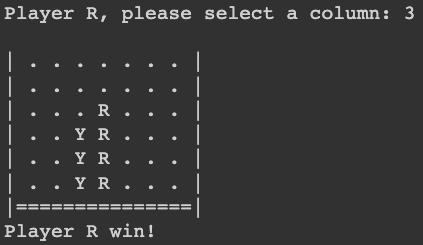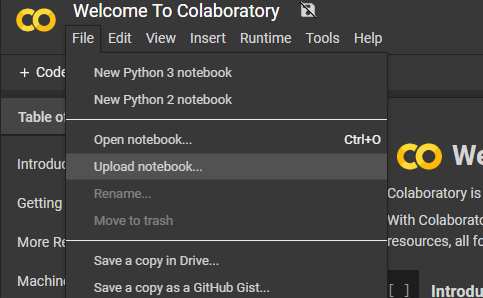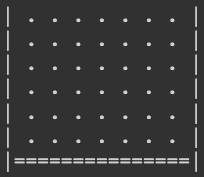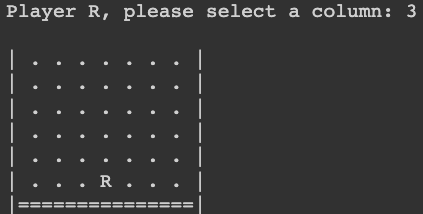3. Connect 4
Worth: 10%
DUE: April 5th; submitted on MOODLE.
- Starting point:
Interpreting requirements correctly
Validating input
Debugging
2D lists
Generalizing rules
Warning
For this assignment, you may work with one other students. Only one of you need to submit your work, but put both your names and student numbers! By all means communicate with each other at a high level (that’s good), but your code needs to be your own here.
Warning
Remember, List vs. Pointer to a List! Review the discussion on Aliasing.
It’s time. With the skills we’ve learned so far, we’re going to make one of the most badass video games of all time. Are you ready? We’re going to make a Connect 4 game from scratch!
For those of you that don’t know what this amazing game is, check out Wikipedia.
This assignment will be a little bit different from the previous two.
DO NOT PANIC THOUGH.
I will still be guiding you through this assignment. Remember, try not to think about solving the problem all at once. We want to solve the little problems. In fact, most of the time we want to break the little problems into littler problems, and then break them down even more… Then, once we write some code, even if it’s 1 or 2 lines, we always make sure those lines do what we expect! Being the good programmers like you are, I am certain that you were going to do this already.
Warning
I’m not playing. Test everything you do in every way you can think to try to break it. This assignment is very constructive. If something early doesn’t work then you’ll be in trouble.
Some of the functions I’ll have you write at first may seem complicated, but don’t worry, it will all come together in the end.
Now, when I say, Connect4, I mean Connect4.

Download the asn3.ipynb notebook from Moodle and upload it to Colab to get started. See below image. WARNING: You should be sure to save a copy of this to your Google drive and then work with that one. You don’t have to, but you will have to re-upload the project every time you want to work on it.

The steps you need to do are laid out, in detail (and suggested order) below.
Warning
Do not alter the function details in the .ipynb/.py files:
Do not change the name of the functions
Do not remove the function description
Do not remove or add to the parameters
3.1. Coding, Part I
Write a function
create_grid()that will simply create a grid (2D list) for the Connect 4 of the correct size 6X7. Initially, you will insert “.” in the lists. Eventually we will replace these “.”” characters with either an ‘R’ or an ‘Y’. Once you are done, test the function! Seriously, test it thoroughly. If these early functions do not work properly, the latter functions are gonna have a bad time. Warning, be careful with pointers here!

Write
is_full(grid)that will verify if the grid is full or not. To know if there is some space left, you just need to verify if there is a.in the grid.Write
get_line_in_col(grid, column)that will return the next free cell in the column starting from the bottom. To know if the cell is free, verify if.is in the cell.Write
drop_token(grid, column, token). This function will take the grid, the column and the token. It will call get_line_in_col to know where to add the token in the column. It will modify the grid for the specific line and column. Finally, it will return the line where the token was placed. Again, once you are done, test the function!

Write the function
check_line(grid, line, token). This function check if the player aligned 4 token (or more) on the same line. To simplify the implementation we start at the beginning of the line. Each time a token of the player is found had 1 to a counter. If the counter each 4, return True. If a token of another player is found, reset the counter to 0. At the end of the line, if the counter never reached 4, return False. Again, once you are done, test the function!Write the function
check_column(grid, column, token). This function check if the player aligned 4 token (or more) on the same column. To simplify the implementation we start at the beginning of the column. Each time a token of the player is found had 1 to a counter. If the counter each 4, return True. If a token of another player is found, reset the counter to 0. At the end of the column, if the counter never reached 4, return False. Again, once you are done, test the function!Write the function
won(grid, line, column, token). This function verifies if the player won. It callscheck_line,check_columnandcheck_diag. If one is true return True. Otherwise return False.
3.2. Coding, Part II
Now it’s time to put all of the above together to actually make the game be a game.
Write a function
connect4()that will set up the game, and perform the execution of Connect 4.
Below is some pseudocode for this function.
create grid initialize the token to R draw the grid while the grid is not full ask the column to the user (input) drop the token in the column and get the line draw the grid see if the player won else figure it out the next player that needs to play (token)
- Some things to note:
R always goes first
The game can end in a draw
3.3. What to submit
Your version of
asn3.py. Also, please DO NOT change the name of this file. Leave it alone.Make sure your NAME and STUDENT NUMBER appear in a comment at the top of the program.
Make sure it’s commented and has function headers!!
Use proper variable names
3.4. General FAQ:
- I don’t know how to do X.
OK, go to google.ca and type in X.
If you are still stuck, come to my office hours.
- It’s not working, therefore Python is broken!
Probably not; you’re very likely doing something wrong
- Can I work with my friend?
Yes, with at most one friend.
- If I submit it at 11:56pm.
11:55pm and earlier is on time. Anything after 11:55pm is late. Anything late is not marked.